Strategic Analysis of Freakomon's Competitive Position: Report
VerifiedAdded on 2019/09/18
|9
|3685
|410
Report
AI Summary
This report analyzes the strategic position of Freakomon, a video game console company, focusing on its competitive environment. The assignment requires a briefing document that includes a stakeholder map, a Porter's Five Forces analysis to assess Freakomon's competitive position, and a recommendation for an information system (IS) or information technology (IT) solution to improve its strategy. The case study provides context on Freakomon's history, its challenges competing with Sony and Microsoft, and the evolving trends in the gaming industry. The analysis considers the company's innovative controller design, market dynamics, and the need to attract a broader customer base beyond traditional gamers. The report also explores the implications of the company's past performance, the importance of third-party game developers, and the impact of periodic market cycles within the video game industry.
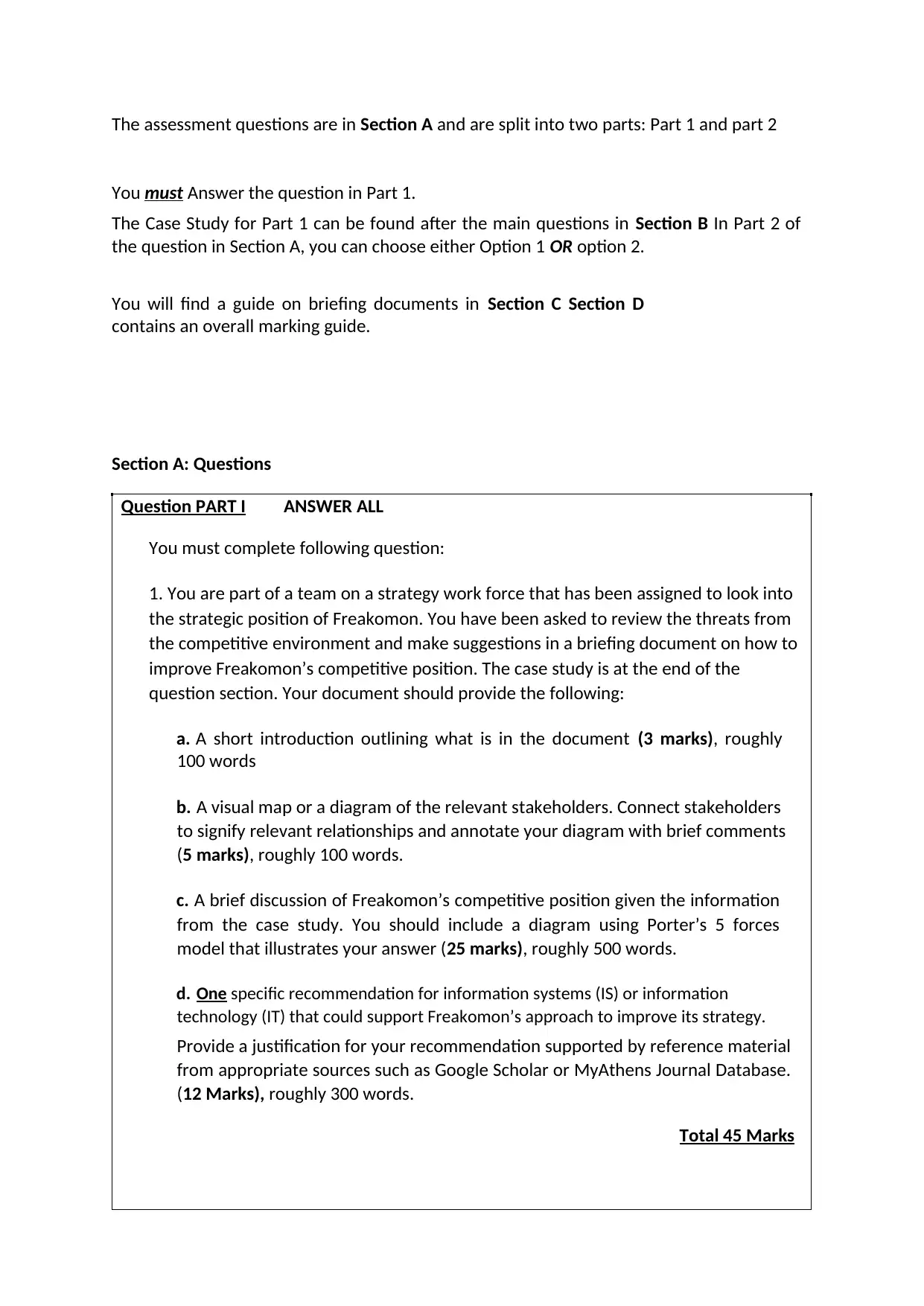
The assessment questions are in Section A and are split into two parts: Part 1 and part 2
You must Answer the question in Part 1.
The Case Study for Part 1 can be found after the main questions in Section B In Part 2 of
the question in Section A, you can choose either Option 1 OR option 2.
You will find a guide on briefing documents in Section C Section D
contains an overall marking guide.
Section A: Questions
Question PART I ANSWER ALL
You must complete following question:
1. You are part of a team on a strategy work force that has been assigned to look into
the strategic position of Freakomon. You have been asked to review the threats from
the competitive environment and make suggestions in a briefing document on how to
improve Freakomon’s competitive position. The case study is at the end of the
question section. Your document should provide the following:
a. A short introduction outlining what is in the document (3 marks), roughly
100 words
b. A visual map or a diagram of the relevant stakeholders. Connect stakeholders
to signify relevant relationships and annotate your diagram with brief comments
(5 marks), roughly 100 words.
c. A brief discussion of Freakomon’s competitive position given the information
from the case study. You should include a diagram using Porter’s 5 forces
model that illustrates your answer (25 marks), roughly 500 words.
d. One specific recommendation for information systems (IS) or information
technology (IT) that could support Freakomon’s approach to improve its strategy.
Provide a justification for your recommendation supported by reference material
from appropriate sources such as Google Scholar or MyAthens Journal Database.
(12 Marks), roughly 300 words.
Total 45 Marks
You must Answer the question in Part 1.
The Case Study for Part 1 can be found after the main questions in Section B In Part 2 of
the question in Section A, you can choose either Option 1 OR option 2.
You will find a guide on briefing documents in Section C Section D
contains an overall marking guide.
Section A: Questions
Question PART I ANSWER ALL
You must complete following question:
1. You are part of a team on a strategy work force that has been assigned to look into
the strategic position of Freakomon. You have been asked to review the threats from
the competitive environment and make suggestions in a briefing document on how to
improve Freakomon’s competitive position. The case study is at the end of the
question section. Your document should provide the following:
a. A short introduction outlining what is in the document (3 marks), roughly
100 words
b. A visual map or a diagram of the relevant stakeholders. Connect stakeholders
to signify relevant relationships and annotate your diagram with brief comments
(5 marks), roughly 100 words.
c. A brief discussion of Freakomon’s competitive position given the information
from the case study. You should include a diagram using Porter’s 5 forces
model that illustrates your answer (25 marks), roughly 500 words.
d. One specific recommendation for information systems (IS) or information
technology (IT) that could support Freakomon’s approach to improve its strategy.
Provide a justification for your recommendation supported by reference material
from appropriate sources such as Google Scholar or MyAthens Journal Database.
(12 Marks), roughly 300 words.
Total 45 Marks
Paraphrase This Document
Need a fresh take? Get an instant paraphrase of this document with our AI Paraphraser
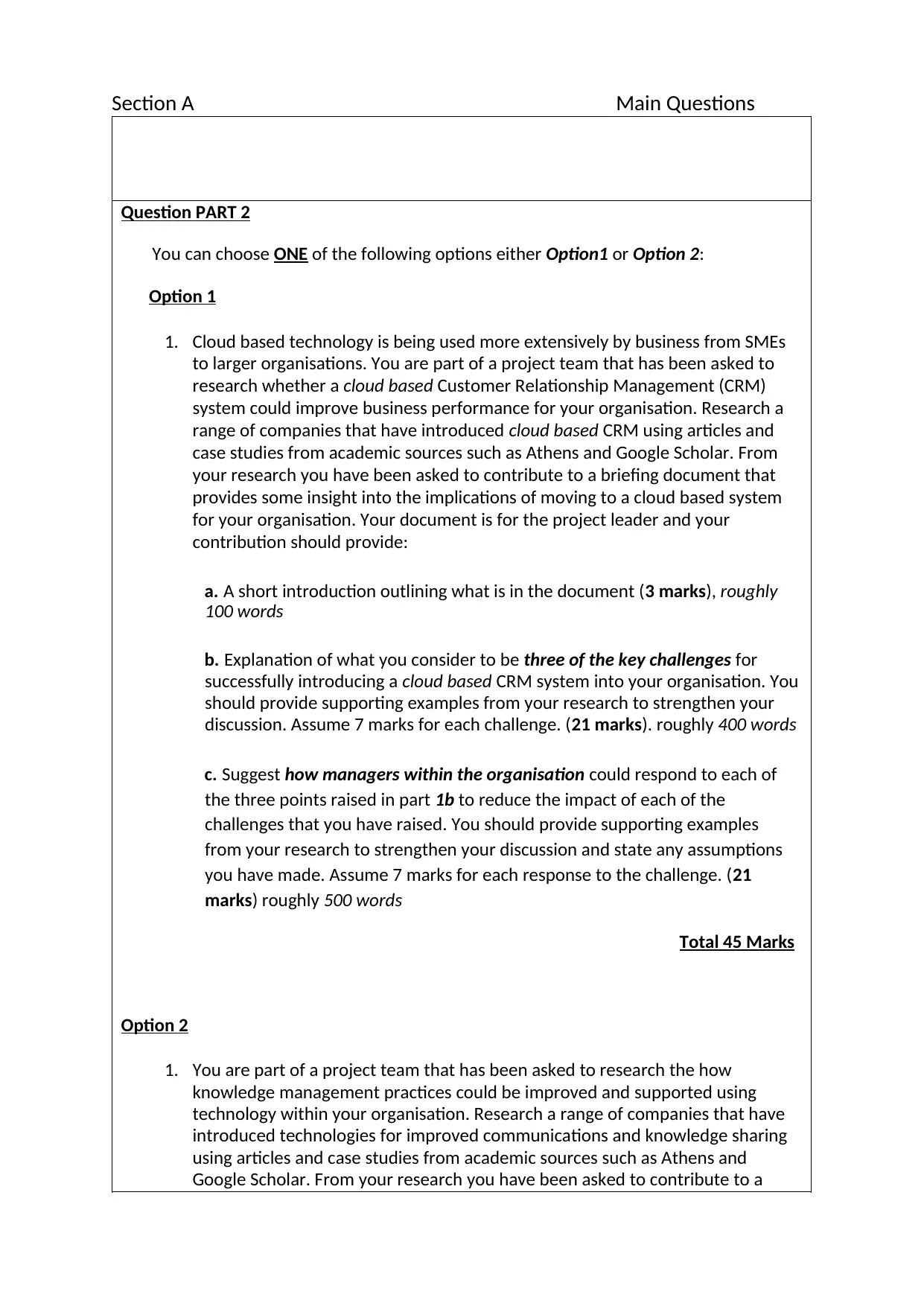
Section A Main Questions
Question PART 2
You can choose ONE of the following options either Option1 or Option 2:
Option 1
1. Cloud based technology is being used more extensively by business from SMEs
to larger organisations. You are part of a project team that has been asked to
research whether a cloud based Customer Relationship Management (CRM)
system could improve business performance for your organisation. Research a
range of companies that have introduced cloud based CRM using articles and
case studies from academic sources such as Athens and Google Scholar. From
your research you have been asked to contribute to a briefing document that
provides some insight into the implications of moving to a cloud based system
for your organisation. Your document is for the project leader and your
contribution should provide:
a. A short introduction outlining what is in the document (3 marks), roughly
100 words
b. Explanation of what you consider to be three of the key challenges for
successfully introducing a cloud based CRM system into your organisation. You
should provide supporting examples from your research to strengthen your
discussion. Assume 7 marks for each challenge. (21 marks). roughly 400 words
c. Suggest how managers within the organisation could respond to each of
the three points raised in part 1b to reduce the impact of each of the
challenges that you have raised. You should provide supporting examples
from your research to strengthen your discussion and state any assumptions
you have made. Assume 7 marks for each response to the challenge. (21
marks) roughly 500 words
Total 45 Marks
Option 2
1. You are part of a project team that has been asked to research the how
knowledge management practices could be improved and supported using
technology within your organisation. Research a range of companies that have
introduced technologies for improved communications and knowledge sharing
using articles and case studies from academic sources such as Athens and
Google Scholar. From your research you have been asked to contribute to a
Question PART 2
You can choose ONE of the following options either Option1 or Option 2:
Option 1
1. Cloud based technology is being used more extensively by business from SMEs
to larger organisations. You are part of a project team that has been asked to
research whether a cloud based Customer Relationship Management (CRM)
system could improve business performance for your organisation. Research a
range of companies that have introduced cloud based CRM using articles and
case studies from academic sources such as Athens and Google Scholar. From
your research you have been asked to contribute to a briefing document that
provides some insight into the implications of moving to a cloud based system
for your organisation. Your document is for the project leader and your
contribution should provide:
a. A short introduction outlining what is in the document (3 marks), roughly
100 words
b. Explanation of what you consider to be three of the key challenges for
successfully introducing a cloud based CRM system into your organisation. You
should provide supporting examples from your research to strengthen your
discussion. Assume 7 marks for each challenge. (21 marks). roughly 400 words
c. Suggest how managers within the organisation could respond to each of
the three points raised in part 1b to reduce the impact of each of the
challenges that you have raised. You should provide supporting examples
from your research to strengthen your discussion and state any assumptions
you have made. Assume 7 marks for each response to the challenge. (21
marks) roughly 500 words
Total 45 Marks
Option 2
1. You are part of a project team that has been asked to research the how
knowledge management practices could be improved and supported using
technology within your organisation. Research a range of companies that have
introduced technologies for improved communications and knowledge sharing
using articles and case studies from academic sources such as Athens and
Google Scholar. From your research you have been asked to contribute to a
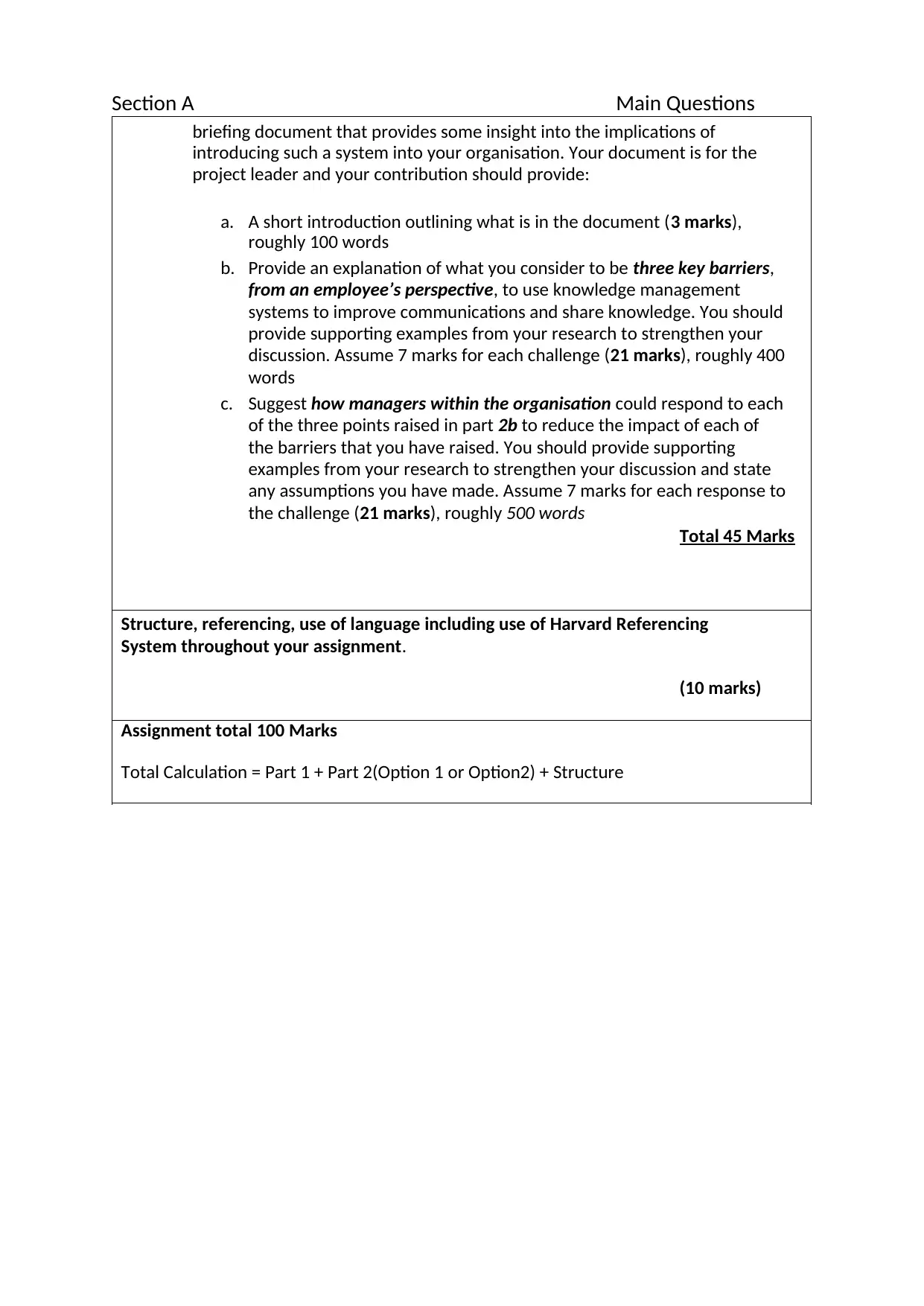
Section A Main Questions
briefing document that provides some insight into the implications of
introducing such a system into your organisation. Your document is for the
project leader and your contribution should provide:
a. A short introduction outlining what is in the document (3 marks),
roughly 100 words
b. Provide an explanation of what you consider to be three key barriers,
from an employee’s perspective, to use knowledge management
systems to improve communications and share knowledge. You should
provide supporting examples from your research to strengthen your
discussion. Assume 7 marks for each challenge (21 marks), roughly 400
words
c. Suggest how managers within the organisation could respond to each
of the three points raised in part 2b to reduce the impact of each of
the barriers that you have raised. You should provide supporting
examples from your research to strengthen your discussion and state
any assumptions you have made. Assume 7 marks for each response to
the challenge (21 marks), roughly 500 words
Total 45 Marks
Structure, referencing, use of language including use of Harvard Referencing
System throughout your assignment.
(10 marks)
Assignment total 100 Marks
Total Calculation = Part 1 + Part 2(Option 1 or Option2) + Structure
briefing document that provides some insight into the implications of
introducing such a system into your organisation. Your document is for the
project leader and your contribution should provide:
a. A short introduction outlining what is in the document (3 marks),
roughly 100 words
b. Provide an explanation of what you consider to be three key barriers,
from an employee’s perspective, to use knowledge management
systems to improve communications and share knowledge. You should
provide supporting examples from your research to strengthen your
discussion. Assume 7 marks for each challenge (21 marks), roughly 400
words
c. Suggest how managers within the organisation could respond to each
of the three points raised in part 2b to reduce the impact of each of
the barriers that you have raised. You should provide supporting
examples from your research to strengthen your discussion and state
any assumptions you have made. Assume 7 marks for each response to
the challenge (21 marks), roughly 500 words
Total 45 Marks
Structure, referencing, use of language including use of Harvard Referencing
System throughout your assignment.
(10 marks)
Assignment total 100 Marks
Total Calculation = Part 1 + Part 2(Option 1 or Option2) + Structure
⊘ This is a preview!⊘
Do you want full access?
Subscribe today to unlock all pages.

Trusted by 1+ million students worldwide
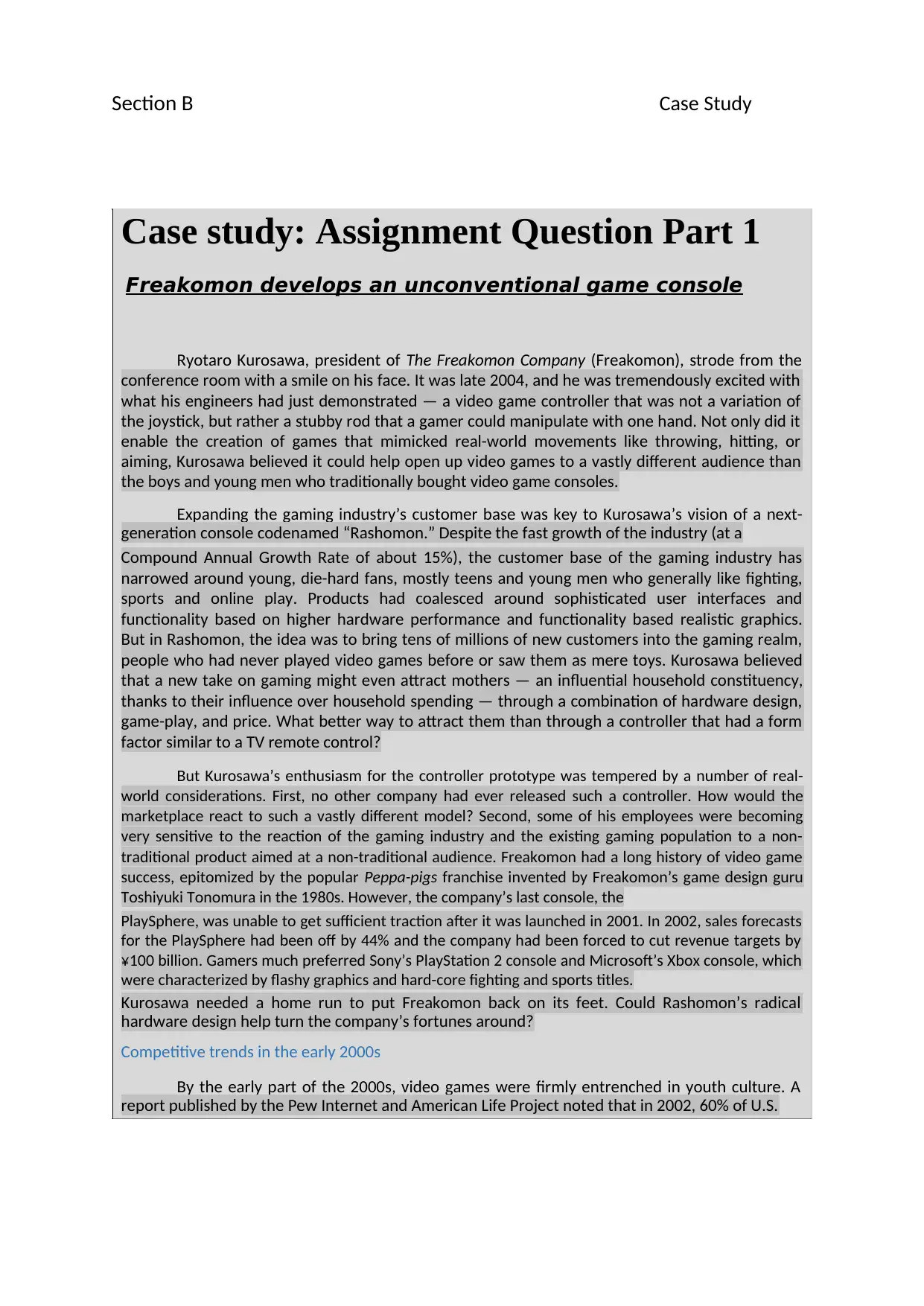
Section B Case Study
Case study: Assignment Question Part 1
Freakomon develops an unconventional game console
Ryotaro Kurosawa, president of The Freakomon Company (Freakomon), strode from the
conference room with a smile on his face. It was late 2004, and he was tremendously excited with
what his engineers had just demonstrated — a video game controller that was not a variation of
the joystick, but rather a stubby rod that a gamer could manipulate with one hand. Not only did it
enable the creation of games that mimicked real-world movements like throwing, hitting, or
aiming, Kurosawa believed it could help open up video games to a vastly different audience than
the boys and young men who traditionally bought video game consoles.
Expanding the gaming industry’s customer base was key to Kurosawa’s vision of a next-
generation console codenamed “Rashomon.” Despite the fast growth of the industry (at a
Compound Annual Growth Rate of about 15%), the customer base of the gaming industry has
narrowed around young, die-hard fans, mostly teens and young men who generally like fighting,
sports and online play. Products had coalesced around sophisticated user interfaces and
functionality based on higher hardware performance and functionality based realistic graphics.
But in Rashomon, the idea was to bring tens of millions of new customers into the gaming realm,
people who had never played video games before or saw them as mere toys. Kurosawa believed
that a new take on gaming might even attract mothers — an influential household constituency,
thanks to their influence over household spending — through a combination of hardware design,
game-play, and price. What better way to attract them than through a controller that had a form
factor similar to a TV remote control?
But Kurosawa’s enthusiasm for the controller prototype was tempered by a number of real-
world considerations. First, no other company had ever released such a controller. How would the
marketplace react to such a vastly different model? Second, some of his employees were becoming
very sensitive to the reaction of the gaming industry and the existing gaming population to a non-
traditional product aimed at a non-traditional audience. Freakomon had a long history of video game
success, epitomized by the popular Peppa-pigs franchise invented by Freakomon’s game design guru
Toshiyuki Tonomura in the 1980s. However, the company’s last console, the
PlaySphere, was unable to get sufficient traction after it was launched in 2001. In 2002, sales forecasts
for the PlaySphere had been off by 44% and the company had been forced to cut revenue targets by
¥100 billion. Gamers much preferred Sony’s PlayStation 2 console and Microsoft’s Xbox console, which
were characterized by flashy graphics and hard-core fighting and sports titles.
Kurosawa needed a home run to put Freakomon back on its feet. Could Rashomon’s radical
hardware design help turn the company’s fortunes around?
Competitive trends in the early 2000s
By the early part of the 2000s, video games were firmly entrenched in youth culture. A
report published by the Pew Internet and American Life Project noted that in 2002, 60% of U.S.
Case study: Assignment Question Part 1
Freakomon develops an unconventional game console
Ryotaro Kurosawa, president of The Freakomon Company (Freakomon), strode from the
conference room with a smile on his face. It was late 2004, and he was tremendously excited with
what his engineers had just demonstrated — a video game controller that was not a variation of
the joystick, but rather a stubby rod that a gamer could manipulate with one hand. Not only did it
enable the creation of games that mimicked real-world movements like throwing, hitting, or
aiming, Kurosawa believed it could help open up video games to a vastly different audience than
the boys and young men who traditionally bought video game consoles.
Expanding the gaming industry’s customer base was key to Kurosawa’s vision of a next-
generation console codenamed “Rashomon.” Despite the fast growth of the industry (at a
Compound Annual Growth Rate of about 15%), the customer base of the gaming industry has
narrowed around young, die-hard fans, mostly teens and young men who generally like fighting,
sports and online play. Products had coalesced around sophisticated user interfaces and
functionality based on higher hardware performance and functionality based realistic graphics.
But in Rashomon, the idea was to bring tens of millions of new customers into the gaming realm,
people who had never played video games before or saw them as mere toys. Kurosawa believed
that a new take on gaming might even attract mothers — an influential household constituency,
thanks to their influence over household spending — through a combination of hardware design,
game-play, and price. What better way to attract them than through a controller that had a form
factor similar to a TV remote control?
But Kurosawa’s enthusiasm for the controller prototype was tempered by a number of real-
world considerations. First, no other company had ever released such a controller. How would the
marketplace react to such a vastly different model? Second, some of his employees were becoming
very sensitive to the reaction of the gaming industry and the existing gaming population to a non-
traditional product aimed at a non-traditional audience. Freakomon had a long history of video game
success, epitomized by the popular Peppa-pigs franchise invented by Freakomon’s game design guru
Toshiyuki Tonomura in the 1980s. However, the company’s last console, the
PlaySphere, was unable to get sufficient traction after it was launched in 2001. In 2002, sales forecasts
for the PlaySphere had been off by 44% and the company had been forced to cut revenue targets by
¥100 billion. Gamers much preferred Sony’s PlayStation 2 console and Microsoft’s Xbox console, which
were characterized by flashy graphics and hard-core fighting and sports titles.
Kurosawa needed a home run to put Freakomon back on its feet. Could Rashomon’s radical
hardware design help turn the company’s fortunes around?
Competitive trends in the early 2000s
By the early part of the 2000s, video games were firmly entrenched in youth culture. A
report published by the Pew Internet and American Life Project noted that in 2002, 60% of U.S.
Paraphrase This Document
Need a fresh take? Get an instant paraphrase of this document with our AI Paraphraser
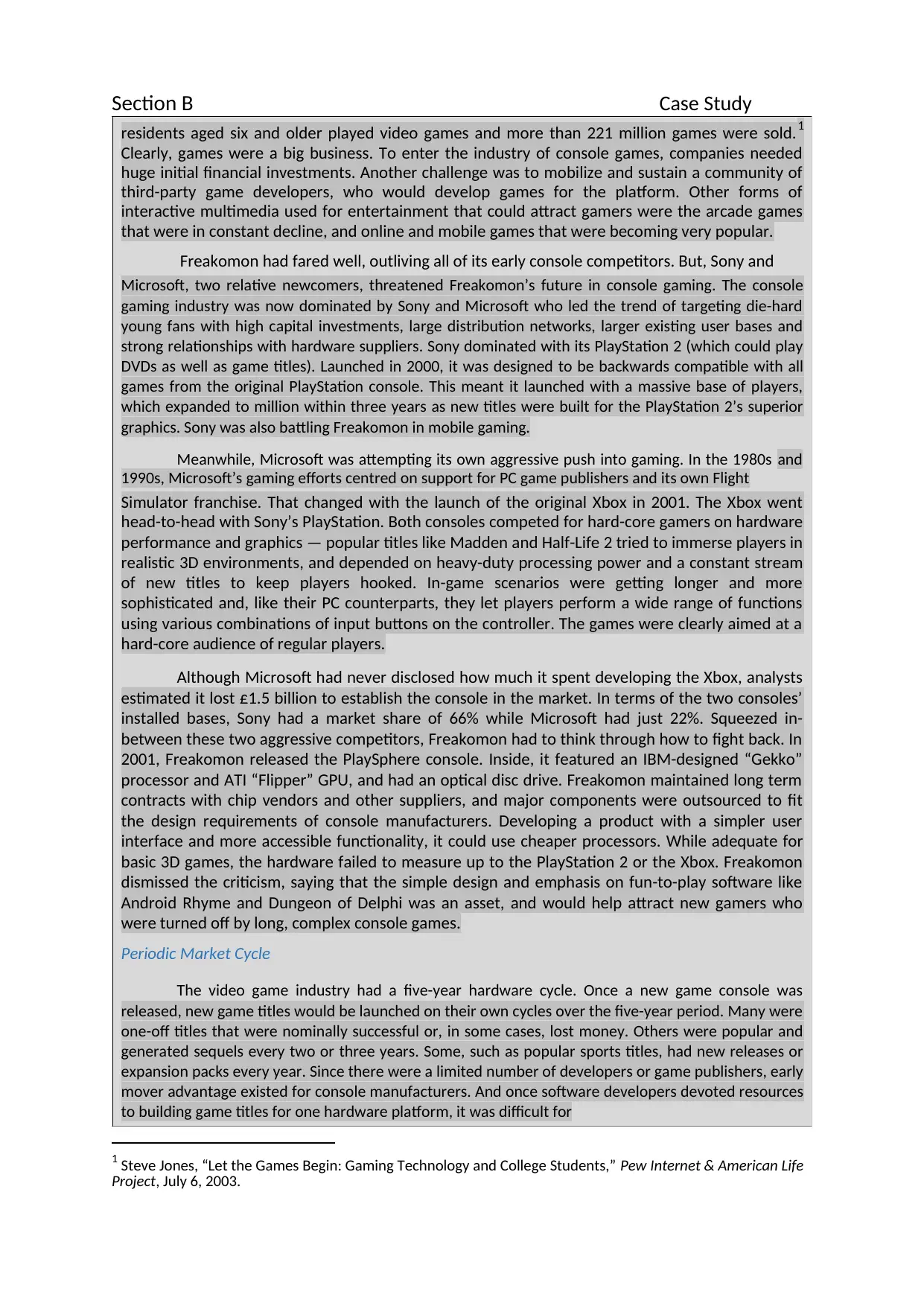
Section B Case Study
residents aged six and older played video games and more than 221 million games were sold.1
Clearly, games were a big business. To enter the industry of console games, companies needed
huge initial financial investments. Another challenge was to mobilize and sustain a community of
third-party game developers, who would develop games for the platform. Other forms of
interactive multimedia used for entertainment that could attract gamers were the arcade games
that were in constant decline, and online and mobile games that were becoming very popular.
Freakomon had fared well, outliving all of its early console competitors. But, Sony and
Microsoft, two relative newcomers, threatened Freakomon’s future in console gaming. The console
gaming industry was now dominated by Sony and Microsoft who led the trend of targeting die-hard
young fans with high capital investments, large distribution networks, larger existing user bases and
strong relationships with hardware suppliers. Sony dominated with its PlayStation 2 (which could play
DVDs as well as game titles). Launched in 2000, it was designed to be backwards compatible with all
games from the original PlayStation console. This meant it launched with a massive base of players,
which expanded to million within three years as new titles were built for the PlayStation 2’s superior
graphics. Sony was also battling Freakomon in mobile gaming.
Meanwhile, Microsoft was attempting its own aggressive push into gaming. In the 1980s and
1990s, Microsoft’s gaming efforts centred on support for PC game publishers and its own Flight
Simulator franchise. That changed with the launch of the original Xbox in 2001. The Xbox went
head-to-head with Sony’s PlayStation. Both consoles competed for hard-core gamers on hardware
performance and graphics — popular titles like Madden and Half-Life 2 tried to immerse players in
realistic 3D environments, and depended on heavy-duty processing power and a constant stream
of new titles to keep players hooked. In-game scenarios were getting longer and more
sophisticated and, like their PC counterparts, they let players perform a wide range of functions
using various combinations of input buttons on the controller. The games were clearly aimed at a
hard-core audience of regular players.
Although Microsoft had never disclosed how much it spent developing the Xbox, analysts
estimated it lost £1.5 billion to establish the console in the market. In terms of the two consoles’
installed bases, Sony had a market share of 66% while Microsoft had just 22%. Squeezed in-
between these two aggressive competitors, Freakomon had to think through how to fight back. In
2001, Freakomon released the PlaySphere console. Inside, it featured an IBM-designed “Gekko”
processor and ATI “Flipper” GPU, and had an optical disc drive. Freakomon maintained long term
contracts with chip vendors and other suppliers, and major components were outsourced to fit
the design requirements of console manufacturers. Developing a product with a simpler user
interface and more accessible functionality, it could use cheaper processors. While adequate for
basic 3D games, the hardware failed to measure up to the PlayStation 2 or the Xbox. Freakomon
dismissed the criticism, saying that the simple design and emphasis on fun-to-play software like
Android Rhyme and Dungeon of Delphi was an asset, and would help attract new gamers who
were turned off by long, complex console games.
Periodic Market Cycle
The video game industry had a five-year hardware cycle. Once a new game console was
released, new game titles would be launched on their own cycles over the five-year period. Many were
one-off titles that were nominally successful or, in some cases, lost money. Others were popular and
generated sequels every two or three years. Some, such as popular sports titles, had new releases or
expansion packs every year. Since there were a limited number of developers or game publishers, early
mover advantage existed for console manufacturers. And once software developers devoted resources
to building game titles for one hardware platform, it was difficult for
1 Steve Jones, “Let the Games Begin: Gaming Technology and College Students,” Pew Internet & American Life
Project, July 6, 2003.
residents aged six and older played video games and more than 221 million games were sold.1
Clearly, games were a big business. To enter the industry of console games, companies needed
huge initial financial investments. Another challenge was to mobilize and sustain a community of
third-party game developers, who would develop games for the platform. Other forms of
interactive multimedia used for entertainment that could attract gamers were the arcade games
that were in constant decline, and online and mobile games that were becoming very popular.
Freakomon had fared well, outliving all of its early console competitors. But, Sony and
Microsoft, two relative newcomers, threatened Freakomon’s future in console gaming. The console
gaming industry was now dominated by Sony and Microsoft who led the trend of targeting die-hard
young fans with high capital investments, large distribution networks, larger existing user bases and
strong relationships with hardware suppliers. Sony dominated with its PlayStation 2 (which could play
DVDs as well as game titles). Launched in 2000, it was designed to be backwards compatible with all
games from the original PlayStation console. This meant it launched with a massive base of players,
which expanded to million within three years as new titles were built for the PlayStation 2’s superior
graphics. Sony was also battling Freakomon in mobile gaming.
Meanwhile, Microsoft was attempting its own aggressive push into gaming. In the 1980s and
1990s, Microsoft’s gaming efforts centred on support for PC game publishers and its own Flight
Simulator franchise. That changed with the launch of the original Xbox in 2001. The Xbox went
head-to-head with Sony’s PlayStation. Both consoles competed for hard-core gamers on hardware
performance and graphics — popular titles like Madden and Half-Life 2 tried to immerse players in
realistic 3D environments, and depended on heavy-duty processing power and a constant stream
of new titles to keep players hooked. In-game scenarios were getting longer and more
sophisticated and, like their PC counterparts, they let players perform a wide range of functions
using various combinations of input buttons on the controller. The games were clearly aimed at a
hard-core audience of regular players.
Although Microsoft had never disclosed how much it spent developing the Xbox, analysts
estimated it lost £1.5 billion to establish the console in the market. In terms of the two consoles’
installed bases, Sony had a market share of 66% while Microsoft had just 22%. Squeezed in-
between these two aggressive competitors, Freakomon had to think through how to fight back. In
2001, Freakomon released the PlaySphere console. Inside, it featured an IBM-designed “Gekko”
processor and ATI “Flipper” GPU, and had an optical disc drive. Freakomon maintained long term
contracts with chip vendors and other suppliers, and major components were outsourced to fit
the design requirements of console manufacturers. Developing a product with a simpler user
interface and more accessible functionality, it could use cheaper processors. While adequate for
basic 3D games, the hardware failed to measure up to the PlayStation 2 or the Xbox. Freakomon
dismissed the criticism, saying that the simple design and emphasis on fun-to-play software like
Android Rhyme and Dungeon of Delphi was an asset, and would help attract new gamers who
were turned off by long, complex console games.
Periodic Market Cycle
The video game industry had a five-year hardware cycle. Once a new game console was
released, new game titles would be launched on their own cycles over the five-year period. Many were
one-off titles that were nominally successful or, in some cases, lost money. Others were popular and
generated sequels every two or three years. Some, such as popular sports titles, had new releases or
expansion packs every year. Since there were a limited number of developers or game publishers, early
mover advantage existed for console manufacturers. And once software developers devoted resources
to building game titles for one hardware platform, it was difficult for
1 Steve Jones, “Let the Games Begin: Gaming Technology and College Students,” Pew Internet & American Life
Project, July 6, 2003.
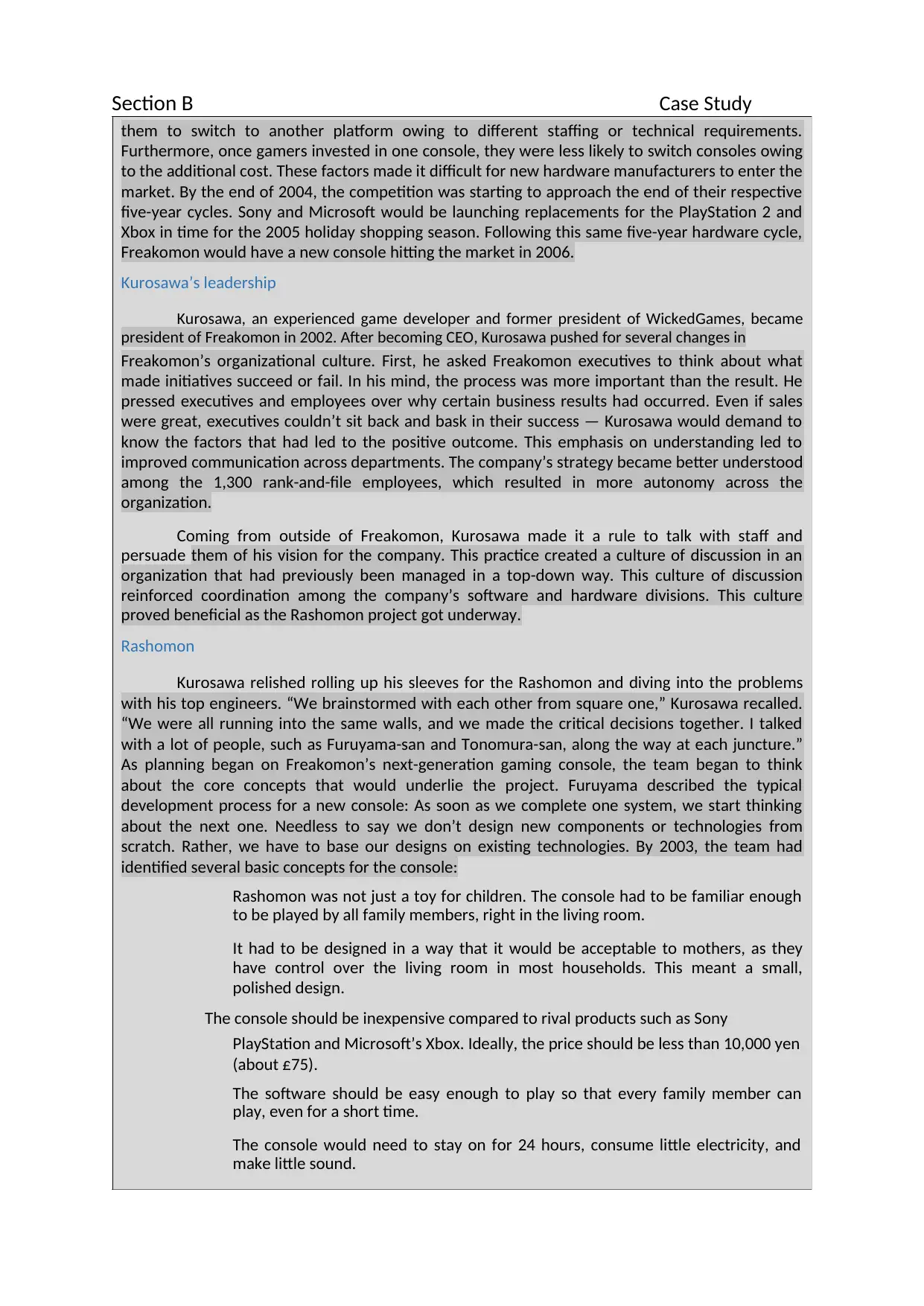
Section B Case Study
them to switch to another platform owing to different staffing or technical requirements.
Furthermore, once gamers invested in one console, they were less likely to switch consoles owing
to the additional cost. These factors made it difficult for new hardware manufacturers to enter the
market. By the end of 2004, the competition was starting to approach the end of their respective
five-year cycles. Sony and Microsoft would be launching replacements for the PlayStation 2 and
Xbox in time for the 2005 holiday shopping season. Following this same five-year hardware cycle,
Freakomon would have a new console hitting the market in 2006.
Kurosawa’s leadership
Kurosawa, an experienced game developer and former president of WickedGames, became
president of Freakomon in 2002. After becoming CEO, Kurosawa pushed for several changes in
Freakomon’s organizational culture. First, he asked Freakomon executives to think about what
made initiatives succeed or fail. In his mind, the process was more important than the result. He
pressed executives and employees over why certain business results had occurred. Even if sales
were great, executives couldn’t sit back and bask in their success — Kurosawa would demand to
know the factors that had led to the positive outcome. This emphasis on understanding led to
improved communication across departments. The company’s strategy became better understood
among the 1,300 rank-and-file employees, which resulted in more autonomy across the
organization.
Coming from outside of Freakomon, Kurosawa made it a rule to talk with staff and
persuade them of his vision for the company. This practice created a culture of discussion in an
organization that had previously been managed in a top-down way. This culture of discussion
reinforced coordination among the company’s software and hardware divisions. This culture
proved beneficial as the Rashomon project got underway.
Rashomon
Kurosawa relished rolling up his sleeves for the Rashomon and diving into the problems
with his top engineers. “We brainstormed with each other from square one,” Kurosawa recalled.
“We were all running into the same walls, and we made the critical decisions together. I talked
with a lot of people, such as Furuyama-san and Tonomura-san, along the way at each juncture.”
As planning began on Freakomon’s next-generation gaming console, the team began to think
about the core concepts that would underlie the project. Furuyama described the typical
development process for a new console: As soon as we complete one system, we start thinking
about the next one. Needless to say we don’t design new components or technologies from
scratch. Rather, we have to base our designs on existing technologies. By 2003, the team had
identified several basic concepts for the console:
Rashomon was not just a toy for children. The console had to be familiar enough
to be played by all family members, right in the living room.
It had to be designed in a way that it would be acceptable to mothers, as they
have control over the living room in most households. This meant a small,
polished design.
The console should be inexpensive compared to rival products such as Sony
PlayStation and Microsoft’s Xbox. Ideally, the price should be less than 10,000 yen
(about £75).
The software should be easy enough to play so that every family member can
play, even for a short time.
The console would need to stay on for 24 hours, consume little electricity, and
make little sound.
them to switch to another platform owing to different staffing or technical requirements.
Furthermore, once gamers invested in one console, they were less likely to switch consoles owing
to the additional cost. These factors made it difficult for new hardware manufacturers to enter the
market. By the end of 2004, the competition was starting to approach the end of their respective
five-year cycles. Sony and Microsoft would be launching replacements for the PlayStation 2 and
Xbox in time for the 2005 holiday shopping season. Following this same five-year hardware cycle,
Freakomon would have a new console hitting the market in 2006.
Kurosawa’s leadership
Kurosawa, an experienced game developer and former president of WickedGames, became
president of Freakomon in 2002. After becoming CEO, Kurosawa pushed for several changes in
Freakomon’s organizational culture. First, he asked Freakomon executives to think about what
made initiatives succeed or fail. In his mind, the process was more important than the result. He
pressed executives and employees over why certain business results had occurred. Even if sales
were great, executives couldn’t sit back and bask in their success — Kurosawa would demand to
know the factors that had led to the positive outcome. This emphasis on understanding led to
improved communication across departments. The company’s strategy became better understood
among the 1,300 rank-and-file employees, which resulted in more autonomy across the
organization.
Coming from outside of Freakomon, Kurosawa made it a rule to talk with staff and
persuade them of his vision for the company. This practice created a culture of discussion in an
organization that had previously been managed in a top-down way. This culture of discussion
reinforced coordination among the company’s software and hardware divisions. This culture
proved beneficial as the Rashomon project got underway.
Rashomon
Kurosawa relished rolling up his sleeves for the Rashomon and diving into the problems
with his top engineers. “We brainstormed with each other from square one,” Kurosawa recalled.
“We were all running into the same walls, and we made the critical decisions together. I talked
with a lot of people, such as Furuyama-san and Tonomura-san, along the way at each juncture.”
As planning began on Freakomon’s next-generation gaming console, the team began to think
about the core concepts that would underlie the project. Furuyama described the typical
development process for a new console: As soon as we complete one system, we start thinking
about the next one. Needless to say we don’t design new components or technologies from
scratch. Rather, we have to base our designs on existing technologies. By 2003, the team had
identified several basic concepts for the console:
Rashomon was not just a toy for children. The console had to be familiar enough
to be played by all family members, right in the living room.
It had to be designed in a way that it would be acceptable to mothers, as they
have control over the living room in most households. This meant a small,
polished design.
The console should be inexpensive compared to rival products such as Sony
PlayStation and Microsoft’s Xbox. Ideally, the price should be less than 10,000 yen
(about £75).
The software should be easy enough to play so that every family member can
play, even for a short time.
The console would need to stay on for 24 hours, consume little electricity, and
make little sound.
⊘ This is a preview!⊘
Do you want full access?
Subscribe today to unlock all pages.

Trusted by 1+ million students worldwide
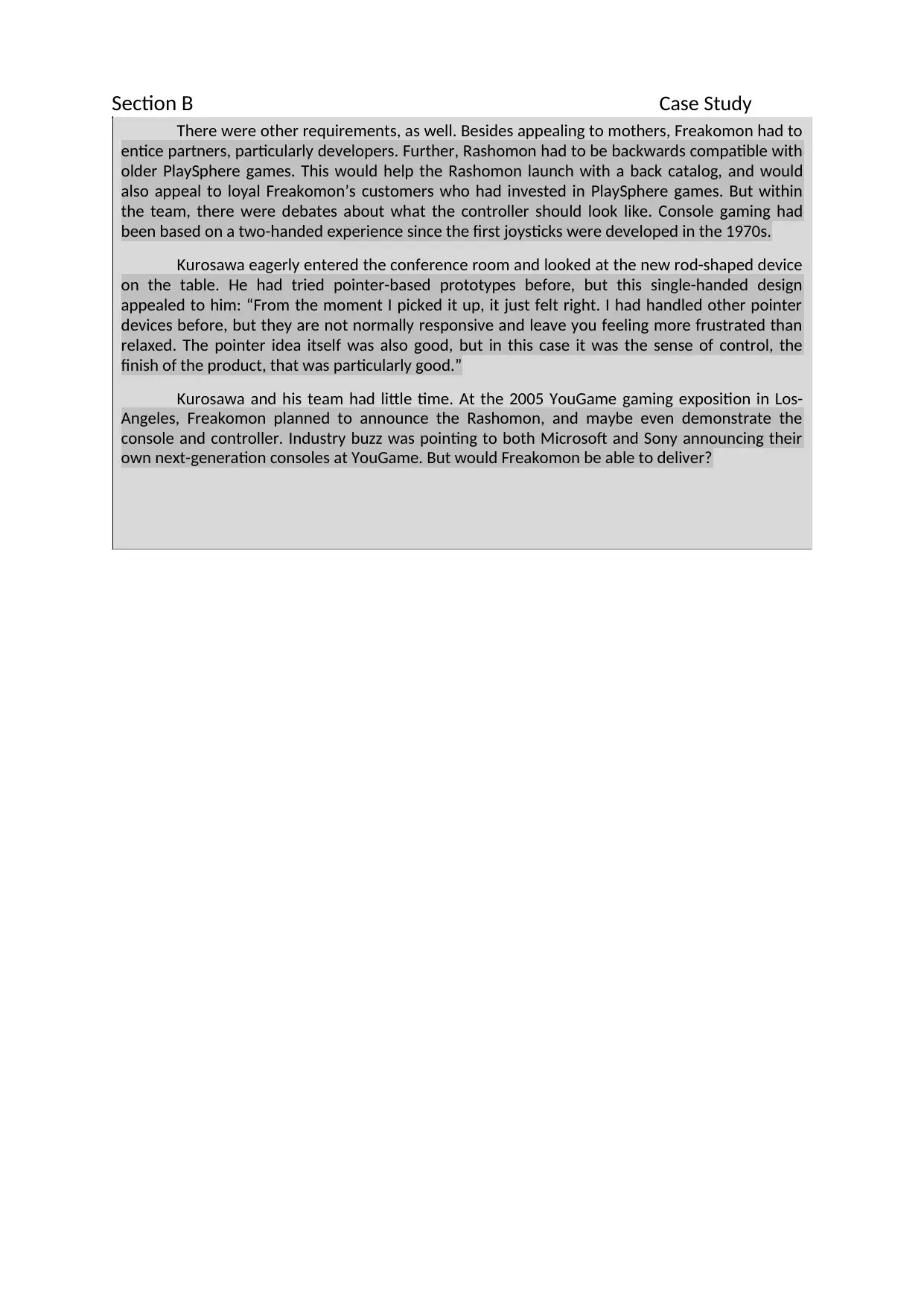
Section B Case Study
There were other requirements, as well. Besides appealing to mothers, Freakomon had to
entice partners, particularly developers. Further, Rashomon had to be backwards compatible with
older PlaySphere games. This would help the Rashomon launch with a back catalog, and would
also appeal to loyal Freakomon’s customers who had invested in PlaySphere games. But within
the team, there were debates about what the controller should look like. Console gaming had
been based on a two-handed experience since the first joysticks were developed in the 1970s.
Kurosawa eagerly entered the conference room and looked at the new rod-shaped device
on the table. He had tried pointer-based prototypes before, but this single-handed design
appealed to him: “From the moment I picked it up, it just felt right. I had handled other pointer
devices before, but they are not normally responsive and leave you feeling more frustrated than
relaxed. The pointer idea itself was also good, but in this case it was the sense of control, the
finish of the product, that was particularly good.”
Kurosawa and his team had little time. At the 2005 YouGame gaming exposition in Los-
Angeles, Freakomon planned to announce the Rashomon, and maybe even demonstrate the
console and controller. Industry buzz was pointing to both Microsoft and Sony announcing their
own next-generation consoles at YouGame. But would Freakomon be able to deliver?
There were other requirements, as well. Besides appealing to mothers, Freakomon had to
entice partners, particularly developers. Further, Rashomon had to be backwards compatible with
older PlaySphere games. This would help the Rashomon launch with a back catalog, and would
also appeal to loyal Freakomon’s customers who had invested in PlaySphere games. But within
the team, there were debates about what the controller should look like. Console gaming had
been based on a two-handed experience since the first joysticks were developed in the 1970s.
Kurosawa eagerly entered the conference room and looked at the new rod-shaped device
on the table. He had tried pointer-based prototypes before, but this single-handed design
appealed to him: “From the moment I picked it up, it just felt right. I had handled other pointer
devices before, but they are not normally responsive and leave you feeling more frustrated than
relaxed. The pointer idea itself was also good, but in this case it was the sense of control, the
finish of the product, that was particularly good.”
Kurosawa and his team had little time. At the 2005 YouGame gaming exposition in Los-
Angeles, Freakomon planned to announce the Rashomon, and maybe even demonstrate the
console and controller. Industry buzz was pointing to both Microsoft and Sony announcing their
own next-generation consoles at YouGame. But would Freakomon be able to deliver?
Paraphrase This Document
Need a fresh take? Get an instant paraphrase of this document with our AI Paraphraser
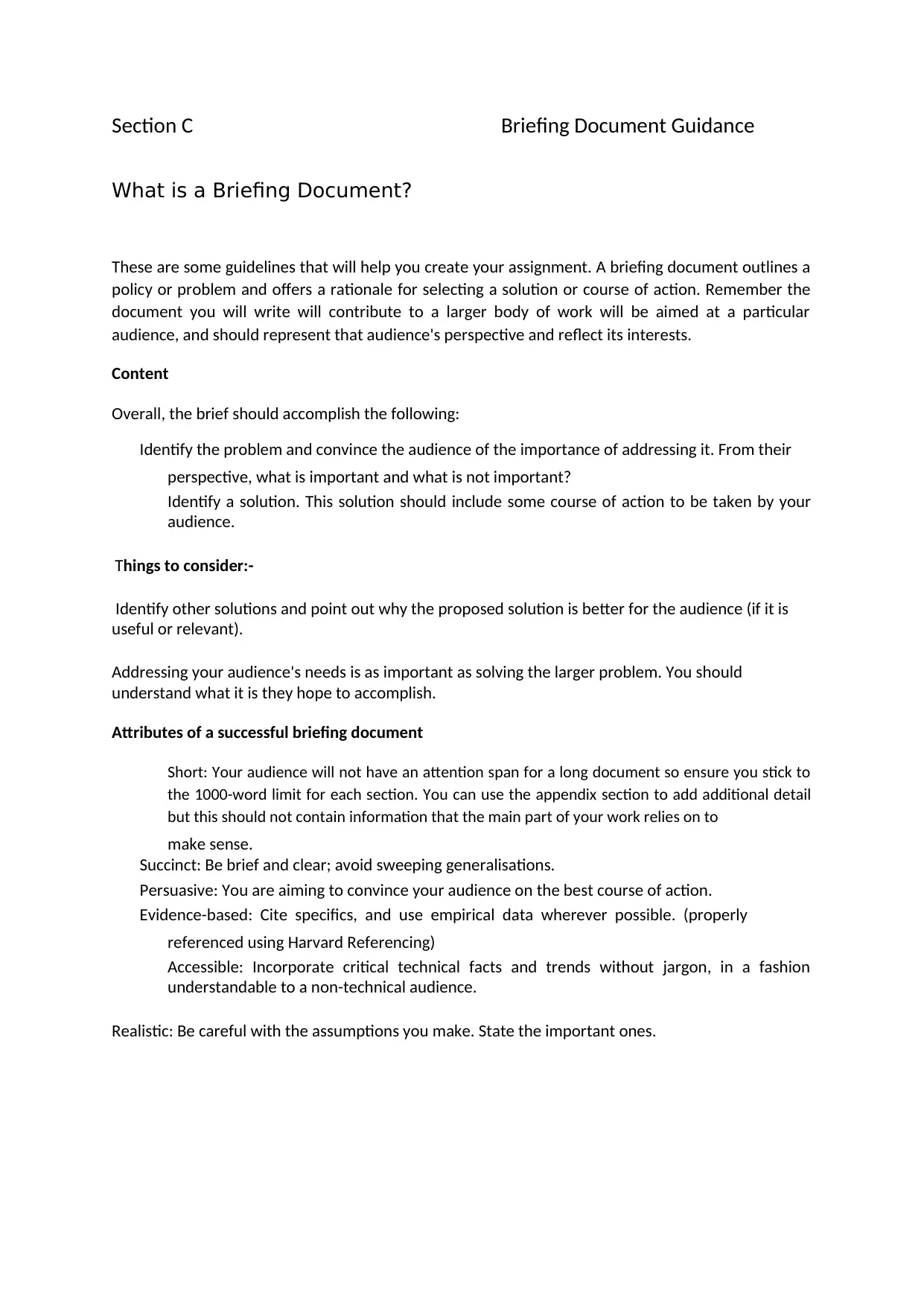
Section C Briefing Document Guidance
What is a Briefing Document?
These are some guidelines that will help you create your assignment. A briefing document outlines a
policy or problem and offers a rationale for selecting a solution or course of action. Remember the
document you will write will contribute to a larger body of work will be aimed at a particular
audience, and should represent that audience's perspective and reflect its interests.
Content
Overall, the brief should accomplish the following:
Identify the problem and convince the audience of the importance of addressing it. From their
perspective, what is important and what is not important?
Identify a solution. This solution should include some course of action to be taken by your
audience.
Things to consider:-
Identify other solutions and point out why the proposed solution is better for the audience (if it is
useful or relevant).
Addressing your audience's needs is as important as solving the larger problem. You should
understand what it is they hope to accomplish.
Attributes of a successful briefing document
Short: Your audience will not have an attention span for a long document so ensure you stick to
the 1000-word limit for each section. You can use the appendix section to add additional detail
but this should not contain information that the main part of your work relies on to
make sense.
Succinct: Be brief and clear; avoid sweeping generalisations.
Persuasive: You are aiming to convince your audience on the best course of action.
Evidence-based: Cite specifics, and use empirical data wherever possible. (properly
referenced using Harvard Referencing)
Accessible: Incorporate critical technical facts and trends without jargon, in a fashion
understandable to a non-technical audience.
Realistic: Be careful with the assumptions you make. State the important ones.
What is a Briefing Document?
These are some guidelines that will help you create your assignment. A briefing document outlines a
policy or problem and offers a rationale for selecting a solution or course of action. Remember the
document you will write will contribute to a larger body of work will be aimed at a particular
audience, and should represent that audience's perspective and reflect its interests.
Content
Overall, the brief should accomplish the following:
Identify the problem and convince the audience of the importance of addressing it. From their
perspective, what is important and what is not important?
Identify a solution. This solution should include some course of action to be taken by your
audience.
Things to consider:-
Identify other solutions and point out why the proposed solution is better for the audience (if it is
useful or relevant).
Addressing your audience's needs is as important as solving the larger problem. You should
understand what it is they hope to accomplish.
Attributes of a successful briefing document
Short: Your audience will not have an attention span for a long document so ensure you stick to
the 1000-word limit for each section. You can use the appendix section to add additional detail
but this should not contain information that the main part of your work relies on to
make sense.
Succinct: Be brief and clear; avoid sweeping generalisations.
Persuasive: You are aiming to convince your audience on the best course of action.
Evidence-based: Cite specifics, and use empirical data wherever possible. (properly
referenced using Harvard Referencing)
Accessible: Incorporate critical technical facts and trends without jargon, in a fashion
understandable to a non-technical audience.
Realistic: Be careful with the assumptions you make. State the important ones.
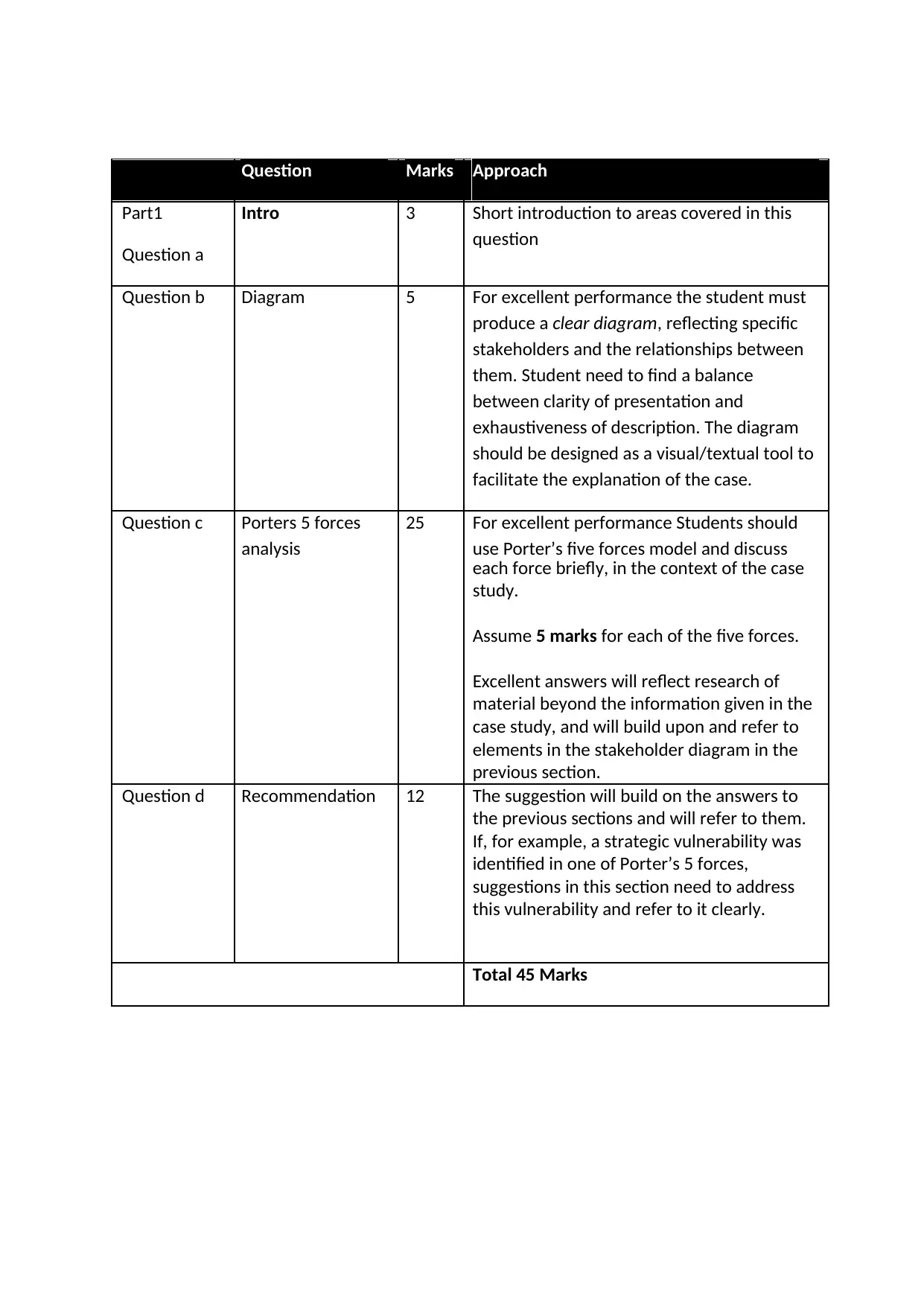
Question Marks Approach
Part1 Intro 3 Short introduction to areas covered in this
Question a question
Question b Diagram 5 For excellent performance the student must
produce a clear diagram, reflecting specific
stakeholders and the relationships between
them. Student need to find a balance
between clarity of presentation and
exhaustiveness of description. The diagram
should be designed as a visual/textual tool to
facilitate the explanation of the case.
Question c Porters 5 forces 25 For excellent performance Students should
analysis use Porter’s five forces model and discuss
each force briefly, in the context of the case
study.
Assume 5 marks for each of the five forces.
Excellent answers will reflect research of
material beyond the information given in the
case study, and will build upon and refer to
elements in the stakeholder diagram in the
previous section.
Question d Recommendation 12 The suggestion will build on the answers to
the previous sections and will refer to them.
If, for example, a strategic vulnerability was
identified in one of Porter’s 5 forces,
suggestions in this section need to address
this vulnerability and refer to it clearly.
Total 45 Marks
Part1 Intro 3 Short introduction to areas covered in this
Question a question
Question b Diagram 5 For excellent performance the student must
produce a clear diagram, reflecting specific
stakeholders and the relationships between
them. Student need to find a balance
between clarity of presentation and
exhaustiveness of description. The diagram
should be designed as a visual/textual tool to
facilitate the explanation of the case.
Question c Porters 5 forces 25 For excellent performance Students should
analysis use Porter’s five forces model and discuss
each force briefly, in the context of the case
study.
Assume 5 marks for each of the five forces.
Excellent answers will reflect research of
material beyond the information given in the
case study, and will build upon and refer to
elements in the stakeholder diagram in the
previous section.
Question d Recommendation 12 The suggestion will build on the answers to
the previous sections and will refer to them.
If, for example, a strategic vulnerability was
identified in one of Porter’s 5 forces,
suggestions in this section need to address
this vulnerability and refer to it clearly.
Total 45 Marks
⊘ This is a preview!⊘
Do you want full access?
Subscribe today to unlock all pages.

Trusted by 1+ million students worldwide
1 out of 9
Related Documents
Your All-in-One AI-Powered Toolkit for Academic Success.
+13062052269
info@desklib.com
Available 24*7 on WhatsApp / Email
![[object Object]](/_next/static/media/star-bottom.7253800d.svg)
Unlock your academic potential
Copyright © 2020–2025 A2Z Services. All Rights Reserved. Developed and managed by ZUCOL.





